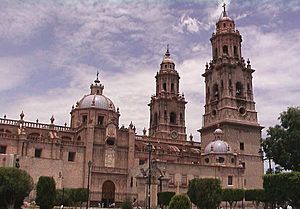José Mariano Elízaga facts for kids
José Damián Elízaga Prado (born September 27, 1786 – died October 2, 1842) was a very important Mexican musician. He was a composer, someone who studied music deeply (a music theorist), a pianist, an organist, and a teacher. He even worked for Emperor Agustín I of Mexico! Many people consider him the first great Mexican composer of the early 1800s.
Life of a Musical Genius
Elízaga was born in Valladolid, which is now called Morelia. He was a child prodigy, meaning he was incredibly talented at music from a very young age. When he was just six years old, he played music for the viceroy, Juan Vicente de Güemes. A viceroy was like a governor who ruled a country in the name of a king. The viceroy was so impressed that he became Elízaga's main supporter and sent him to a special school called the Colegio de Infantes de la Catedral.
Later, Elízaga returned to Valladolid. In 1799, he worked as an organist in Morelia. He bought the best pianoforte (an early type of piano) in Mexico City. He used it to teach music to the wealthy and important families, known as the aristocracy, in the area. One of his students was Ana María de Huarte y Muñiz, who later married Agustín de Iturbide. Agustín de Iturbide became the emperor of the First Mexican Empire.
In 1822, Elízaga was chosen to be the "maestro de capilla" (which means music director or Kapellmeister) for the Imperial Chapel. In 1823, he published his book Elementos de música in Mexico City. You can still find a copy of this important book in the National Library of Mexico today.
Even though the First Mexican Empire ended, which was a tough time for him, the Mexican government continued to support Elízaga. He helped set up the way music would be organized in Mexico during the 1800s. He helped start the first Philharmonic Society of Mexico, which was a group for people who loved music.
In 1825, he founded the Philharmonic Academy. This academy later became the first conservatory (a special school for music) in all of the Americas! The next year, in 1826, he started the first music press in Mexico. This was a place where he could print his own musical works and the works of other Mexican composers. Soon, Elízaga was seen as the best Mexican composer of his time.
In 1835, he published another important book called Principios de la armonía y de la melodía (Principles of harmony and melody). This book was a huge help to music theory (the study of how music works) in Mexico during the 1800s. He retired to Morelia in 1842 and passed away there at the age of 56.
Today, not many of Elízaga's original music scores have survived. However, since 1994, many have been found. One example is his Ultimas Variaciones (Last Variations) for keyboard. This piece shows that he was greatly influenced by the famous composer Joseph Haydn.
Musical Works
Elízaga wrote different kinds of music:
- Church music: This music was written for religious services. Some of his pieces include Dúo de las siete palabras, Lamentaciones, Maitines de la transfiguración, Misas (Masses), Miserere, and Oficios.
- Secular music: This music was not for church. Some examples are El 16 de Septiembre, Inclito gran Morelos, Seis valses (Six Waltzes), Vals con variaciones a la memoria de Rossini (Waltz with variations in memory of Rossini), and Ultimas variaciones (Last Variations).
See also
 In Spanish: José Mariano Elízaga para niños
In Spanish: José Mariano Elízaga para niños


